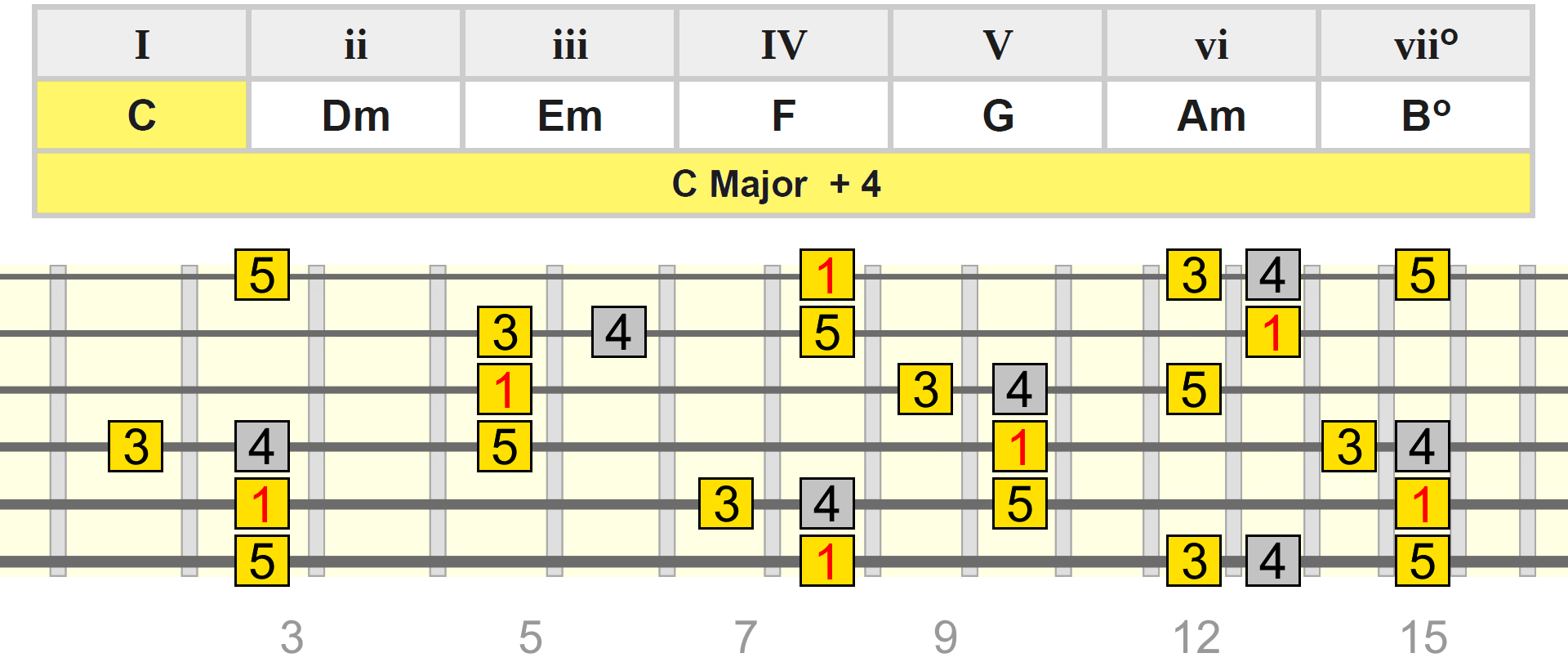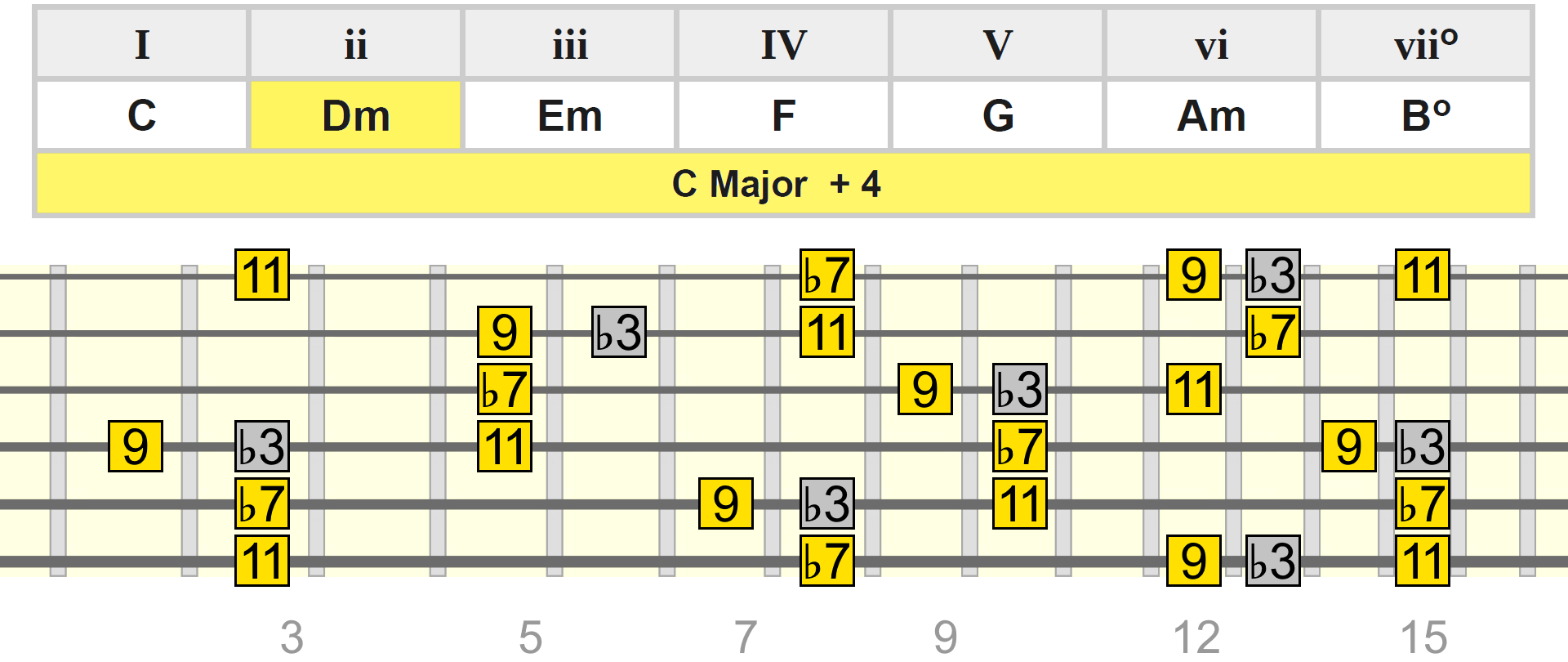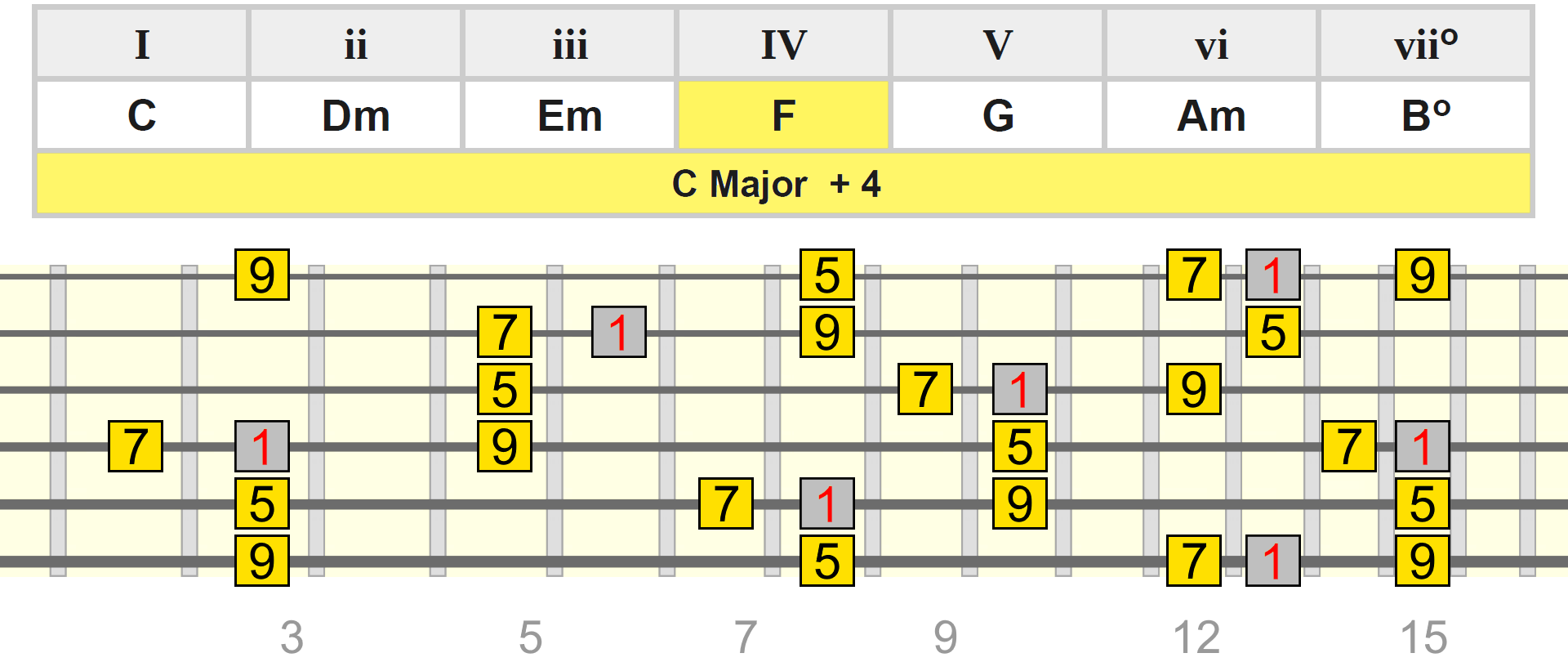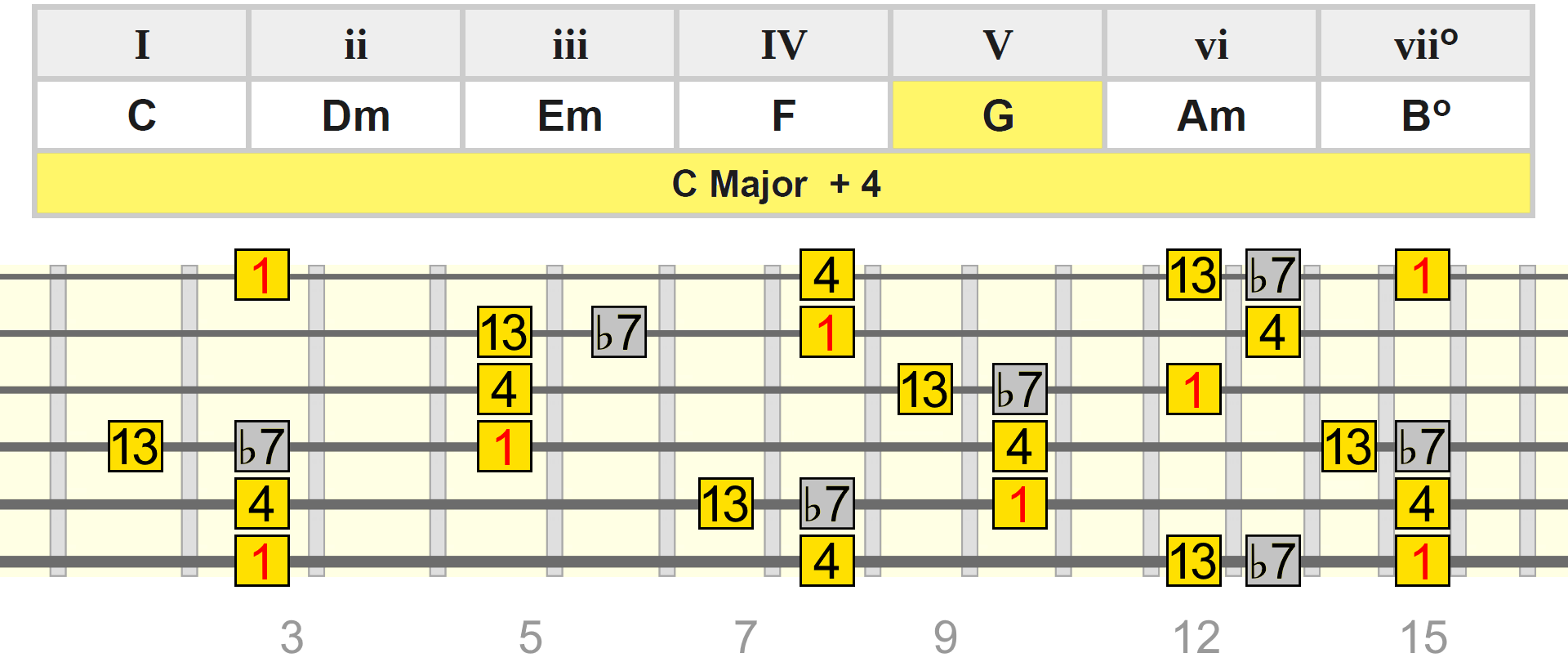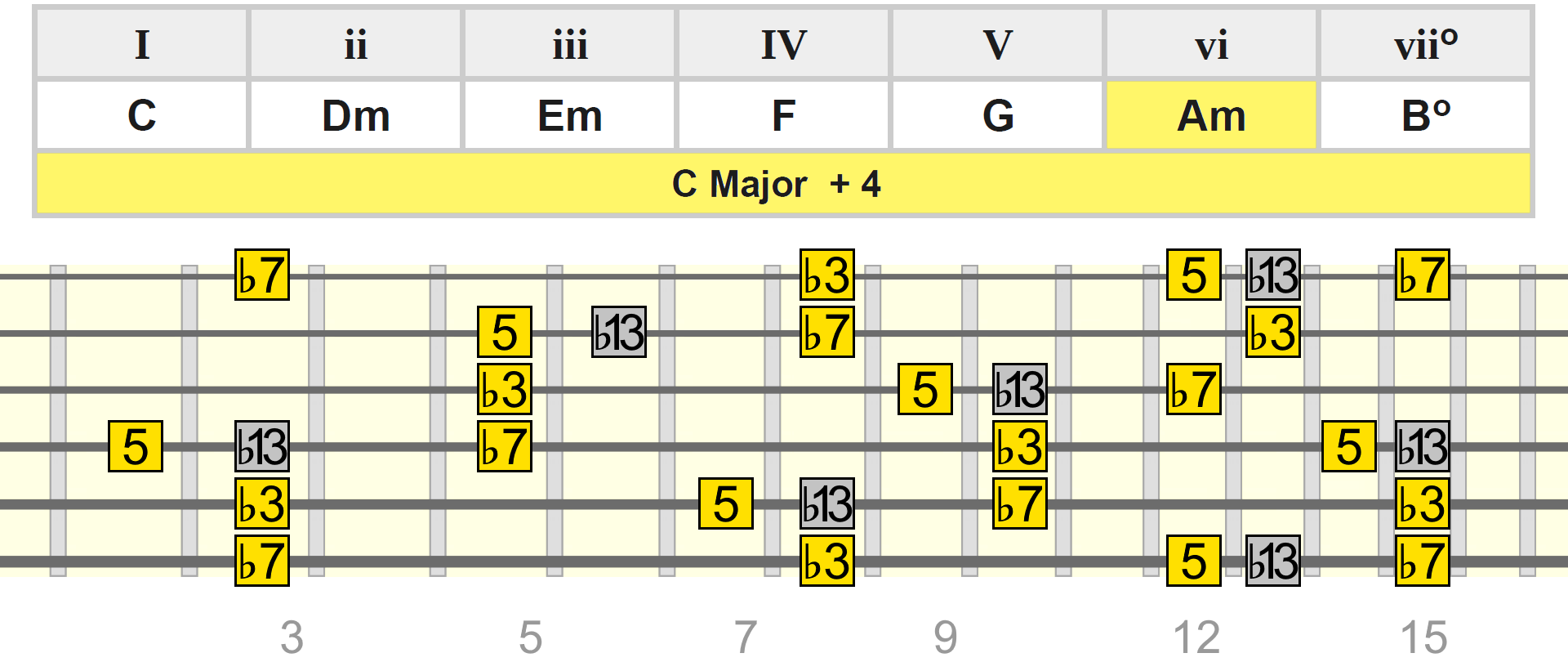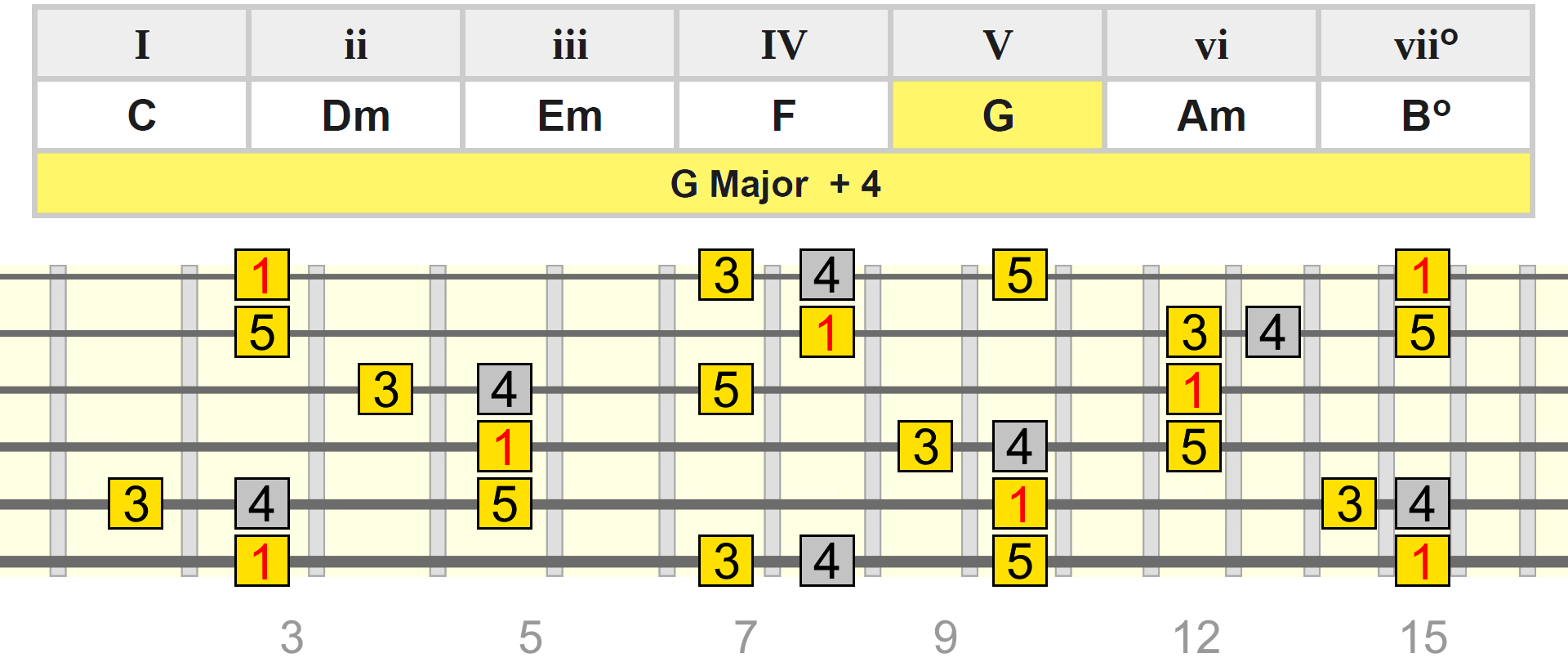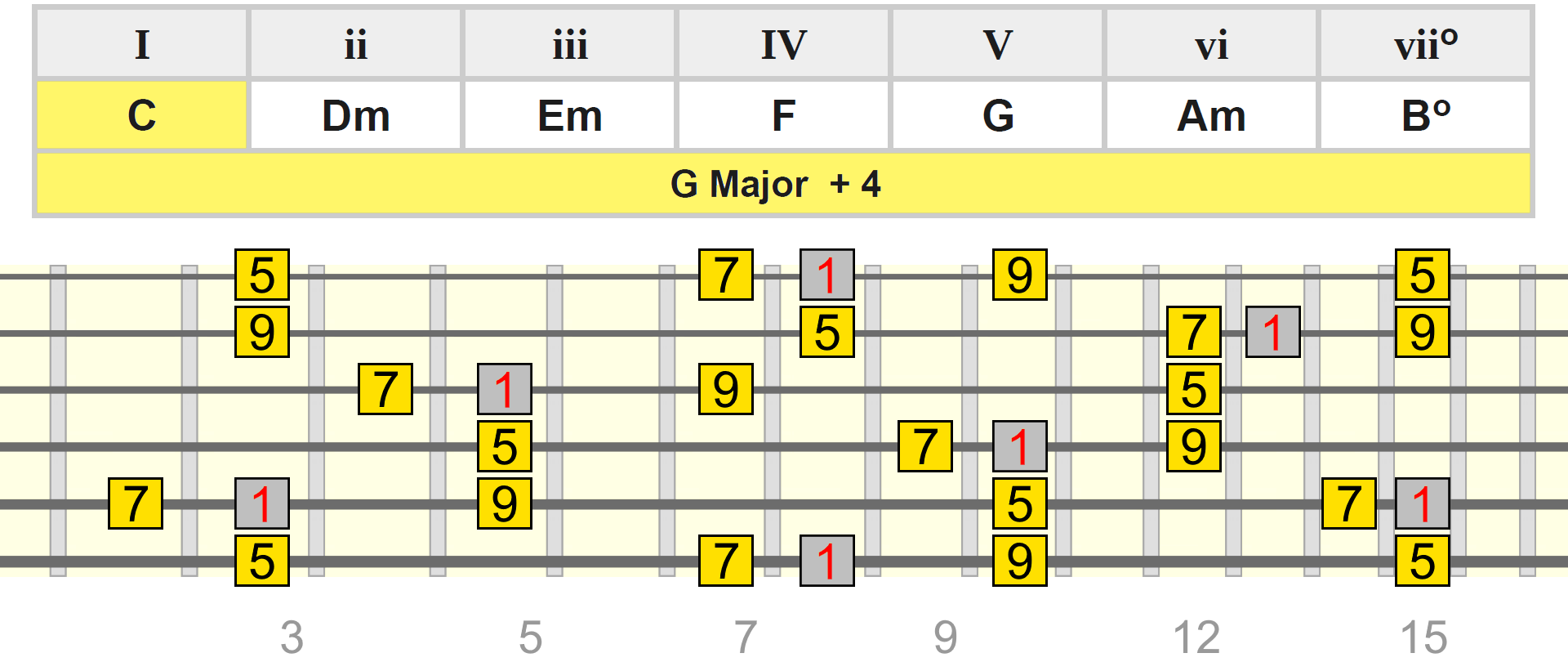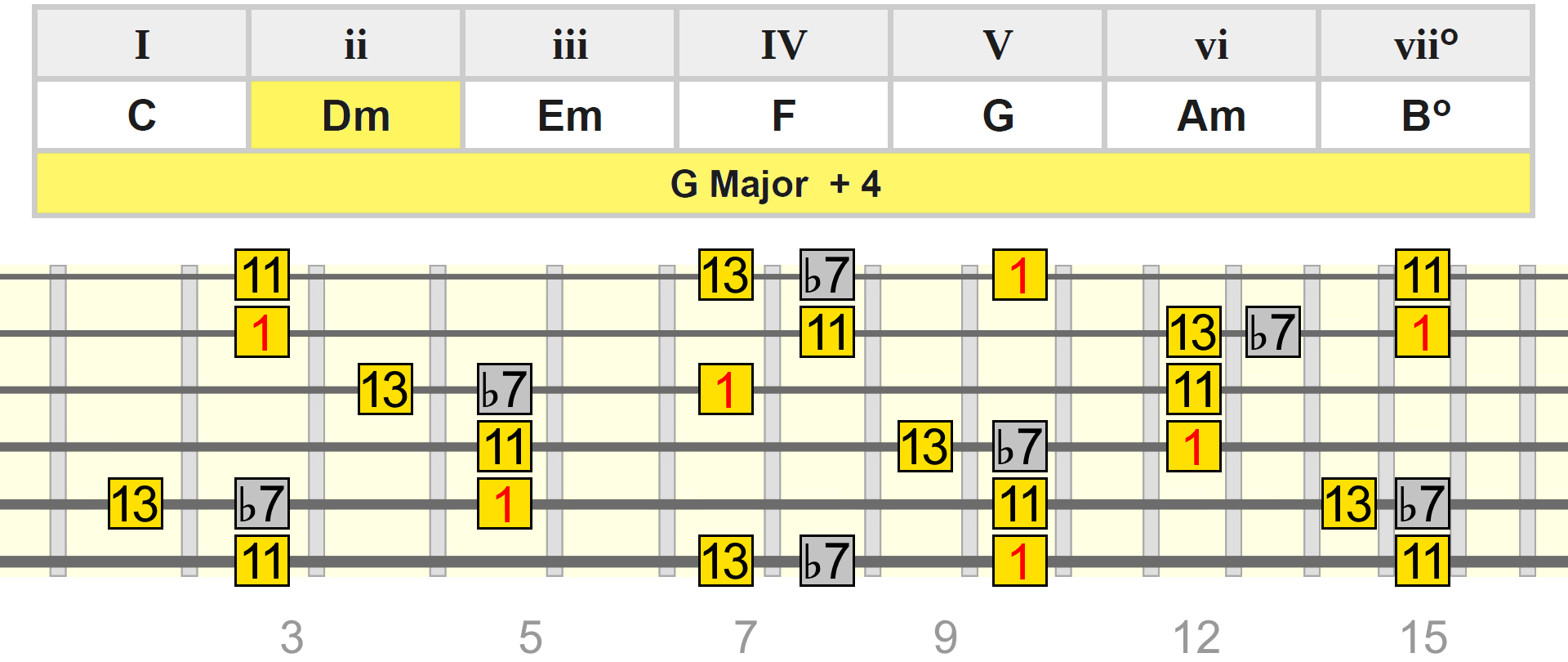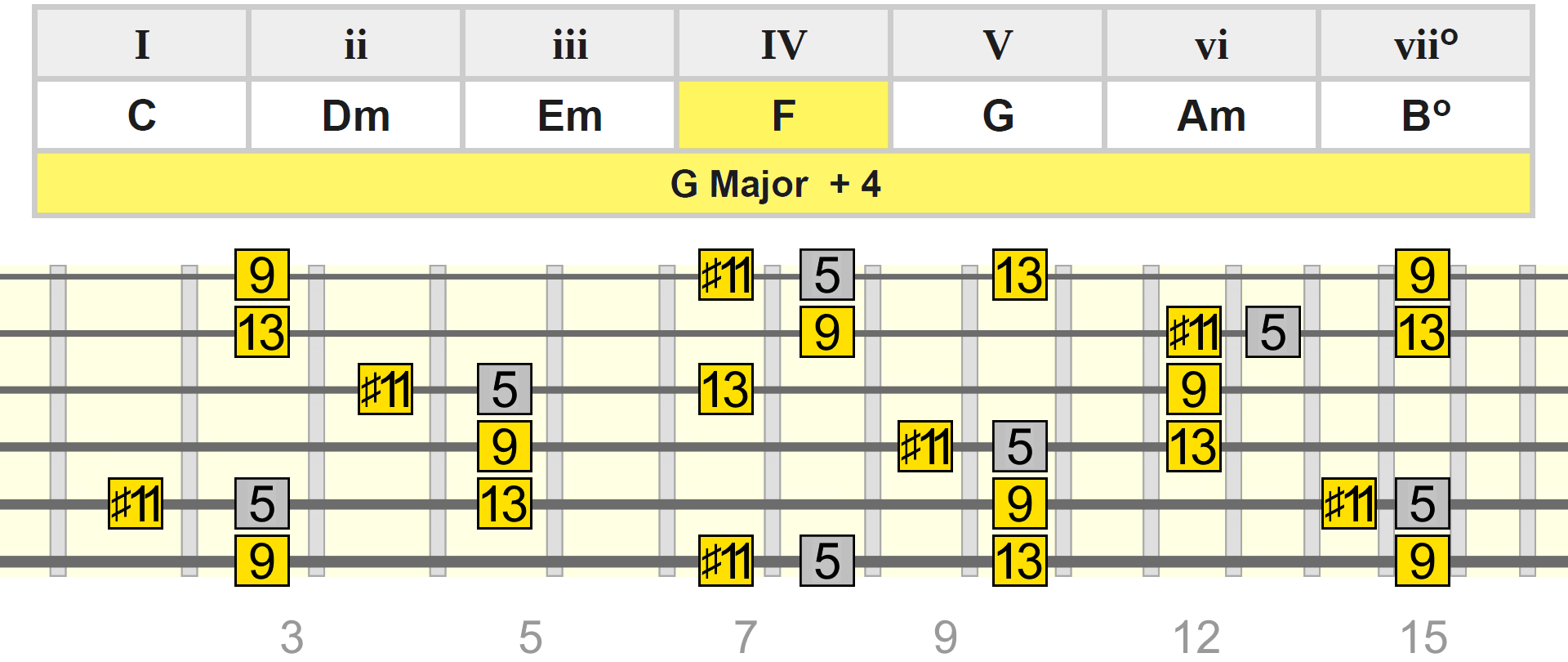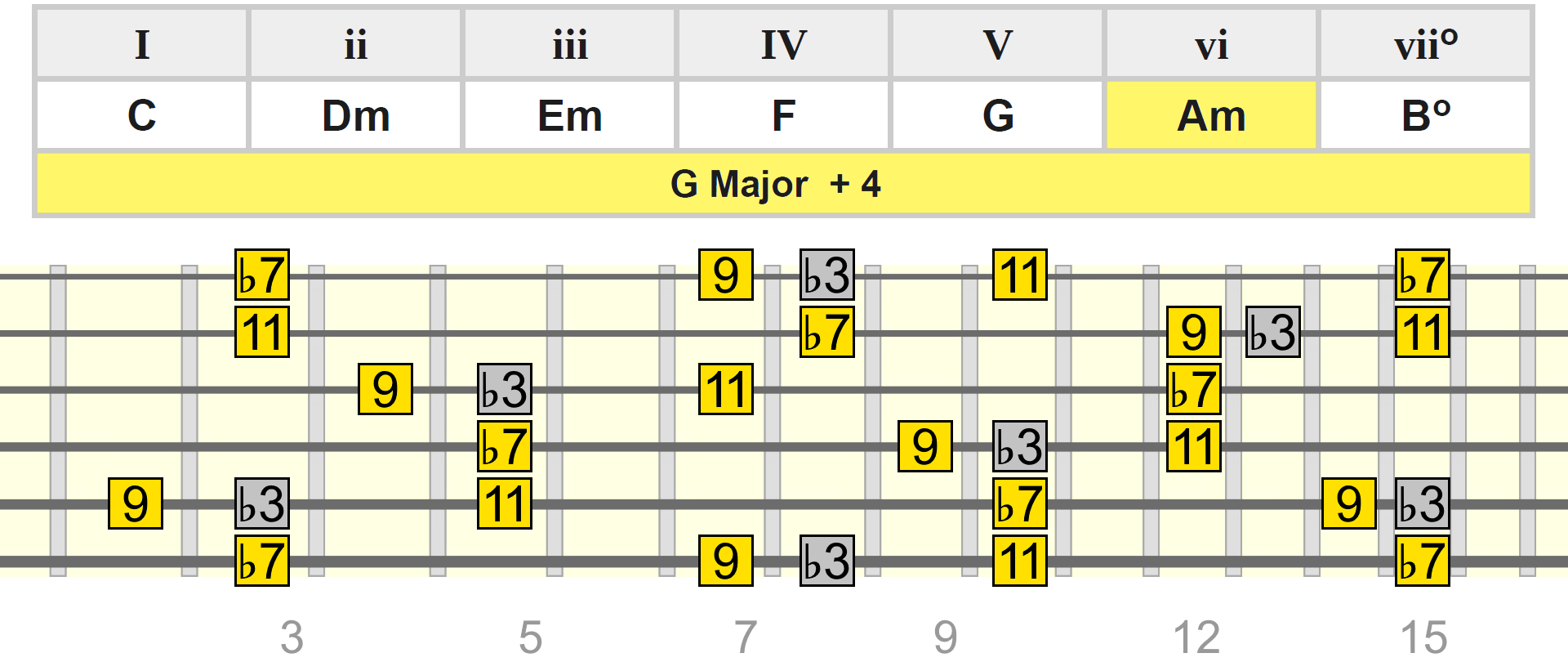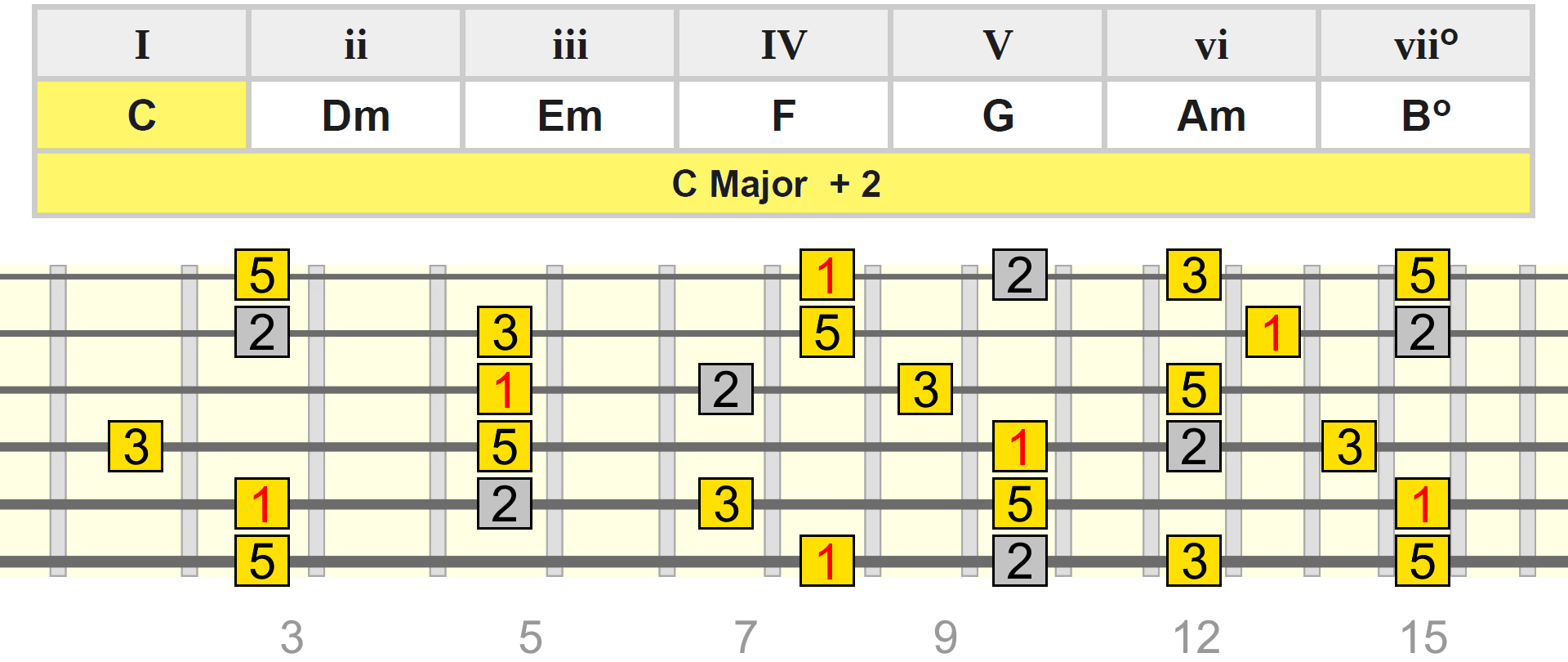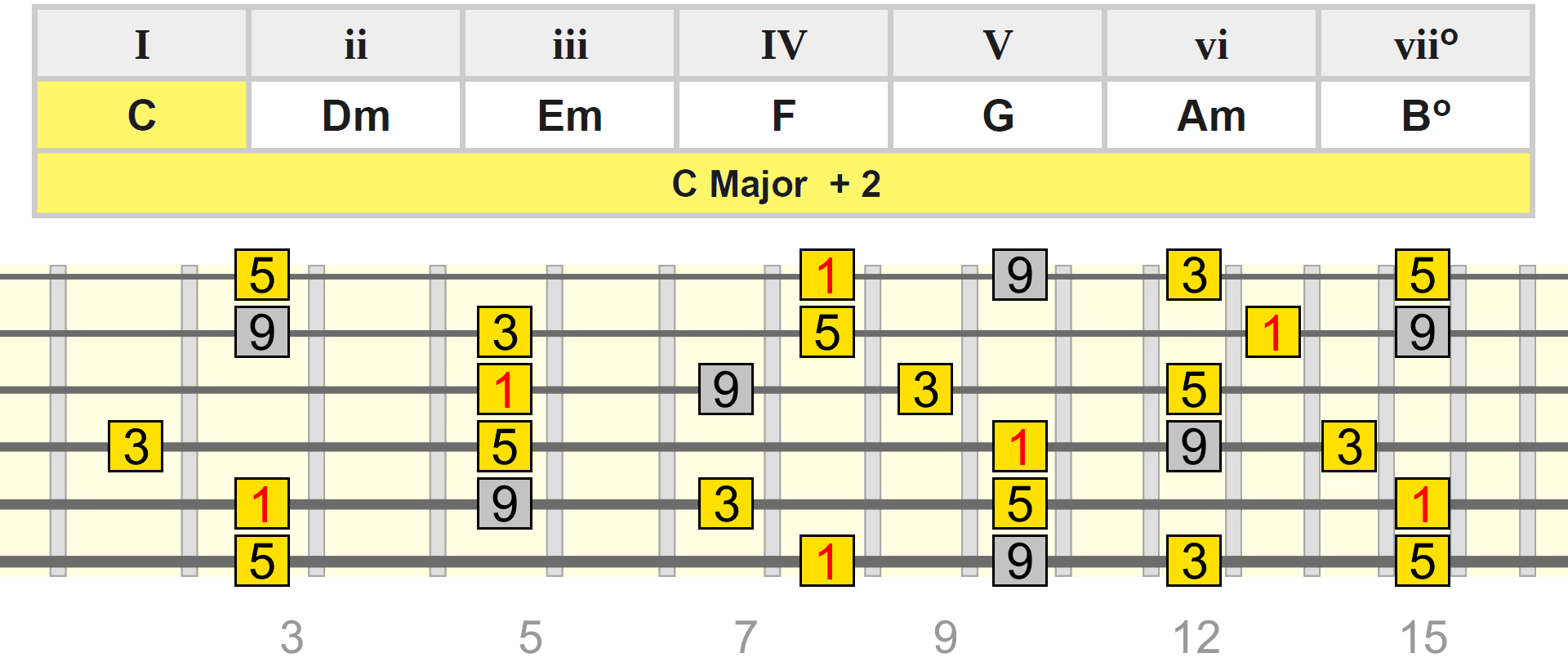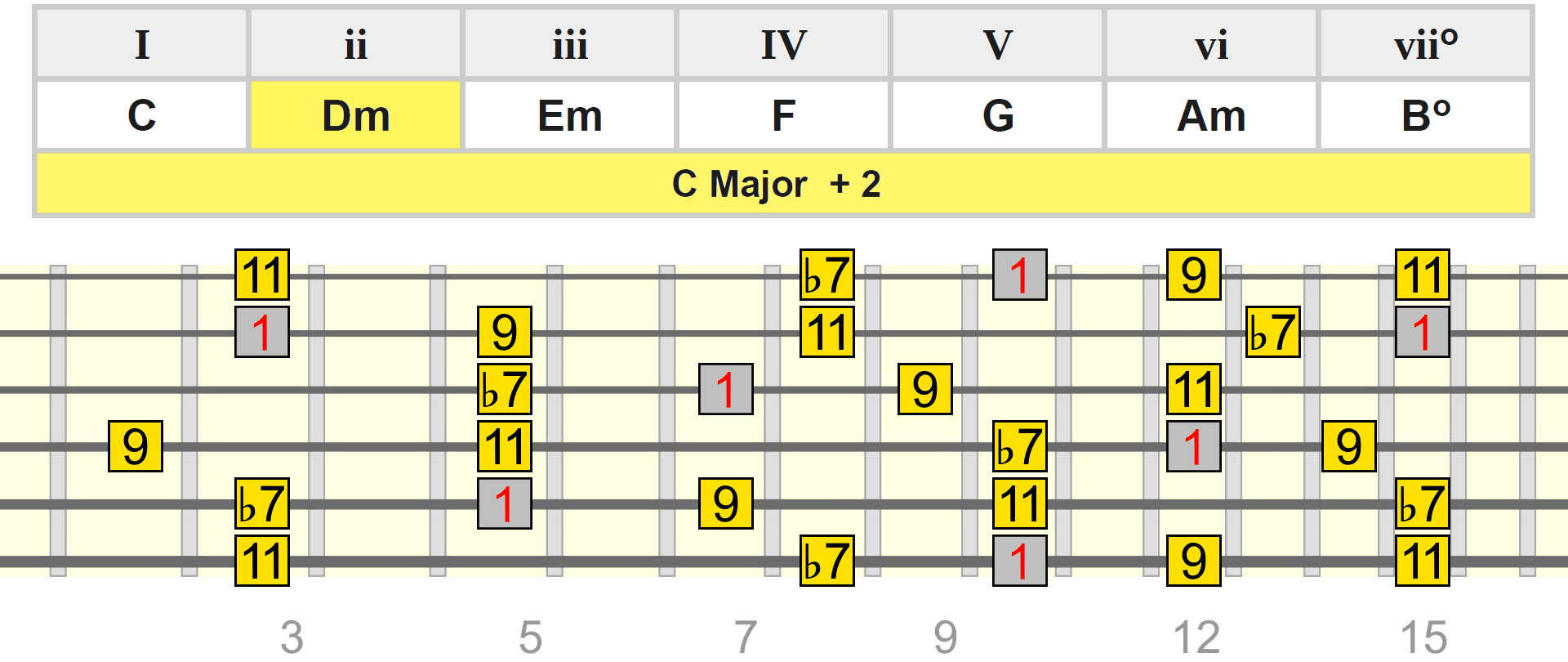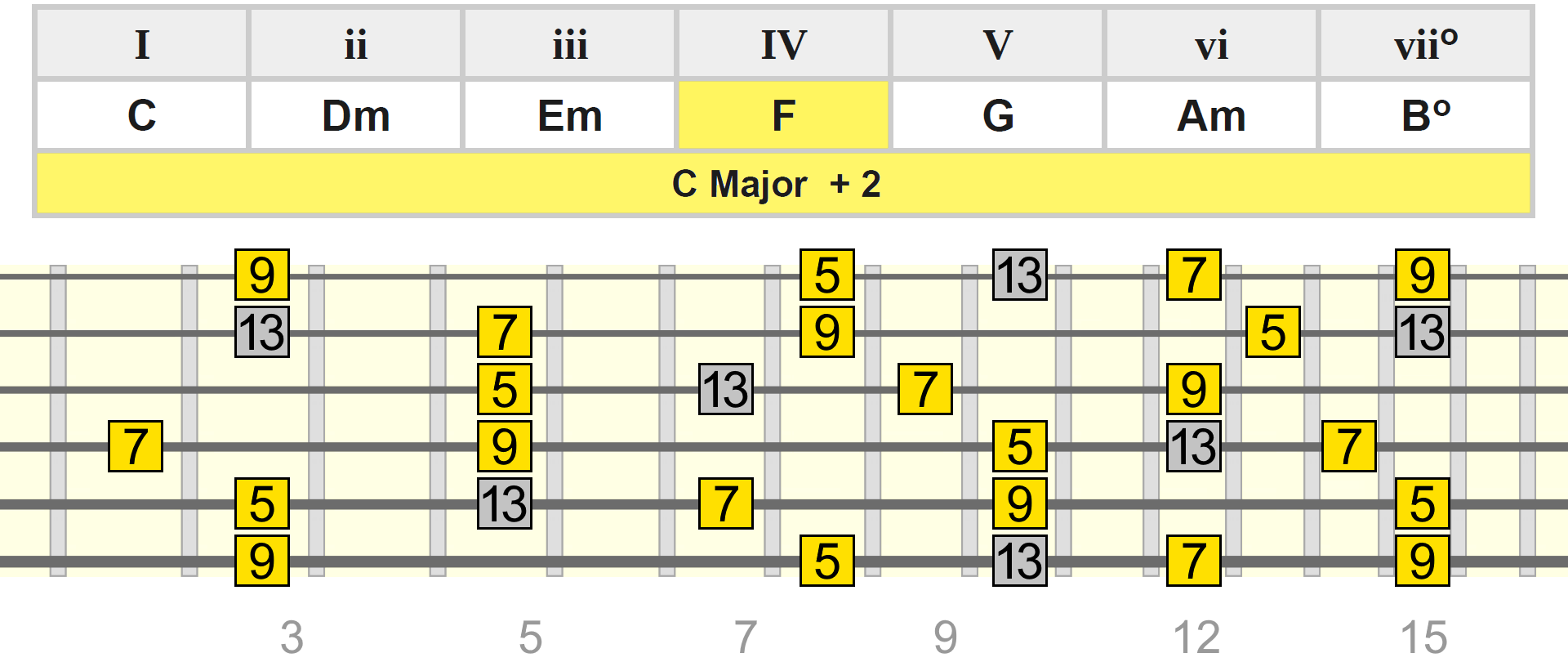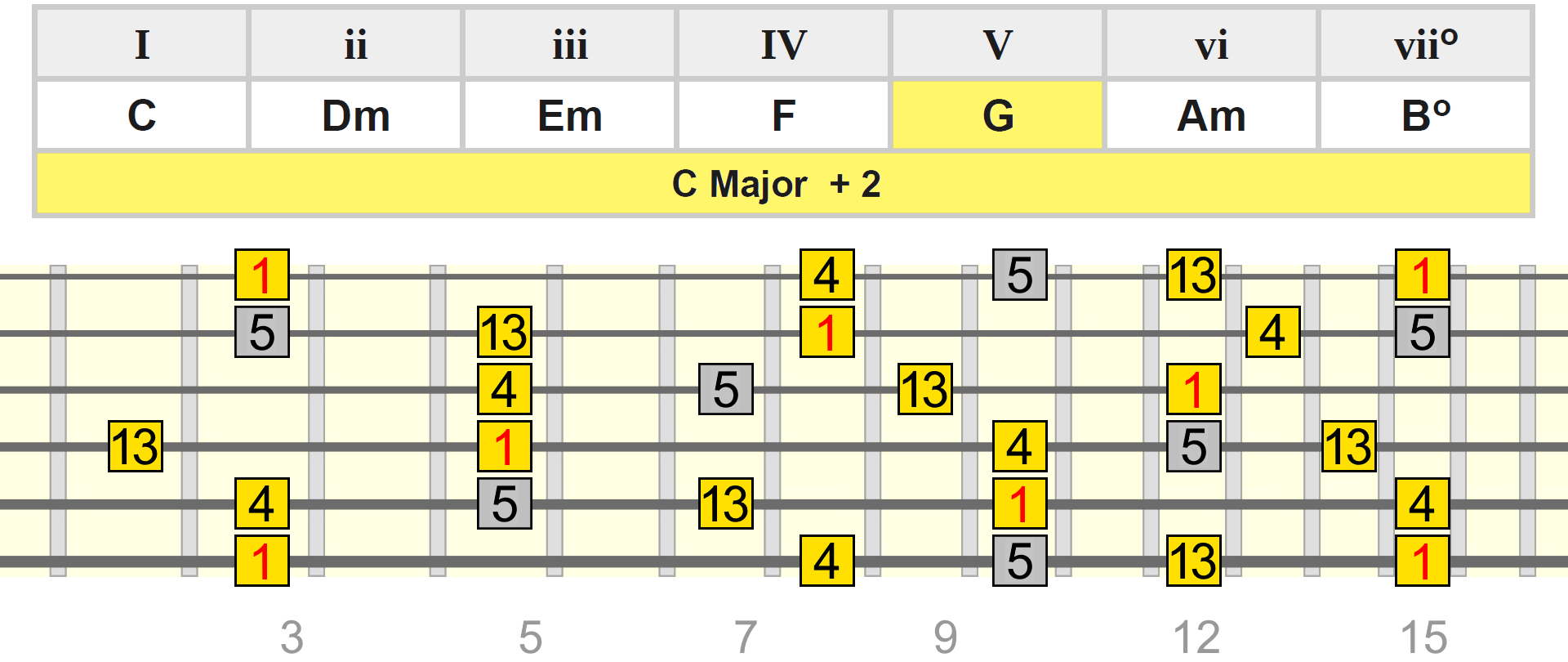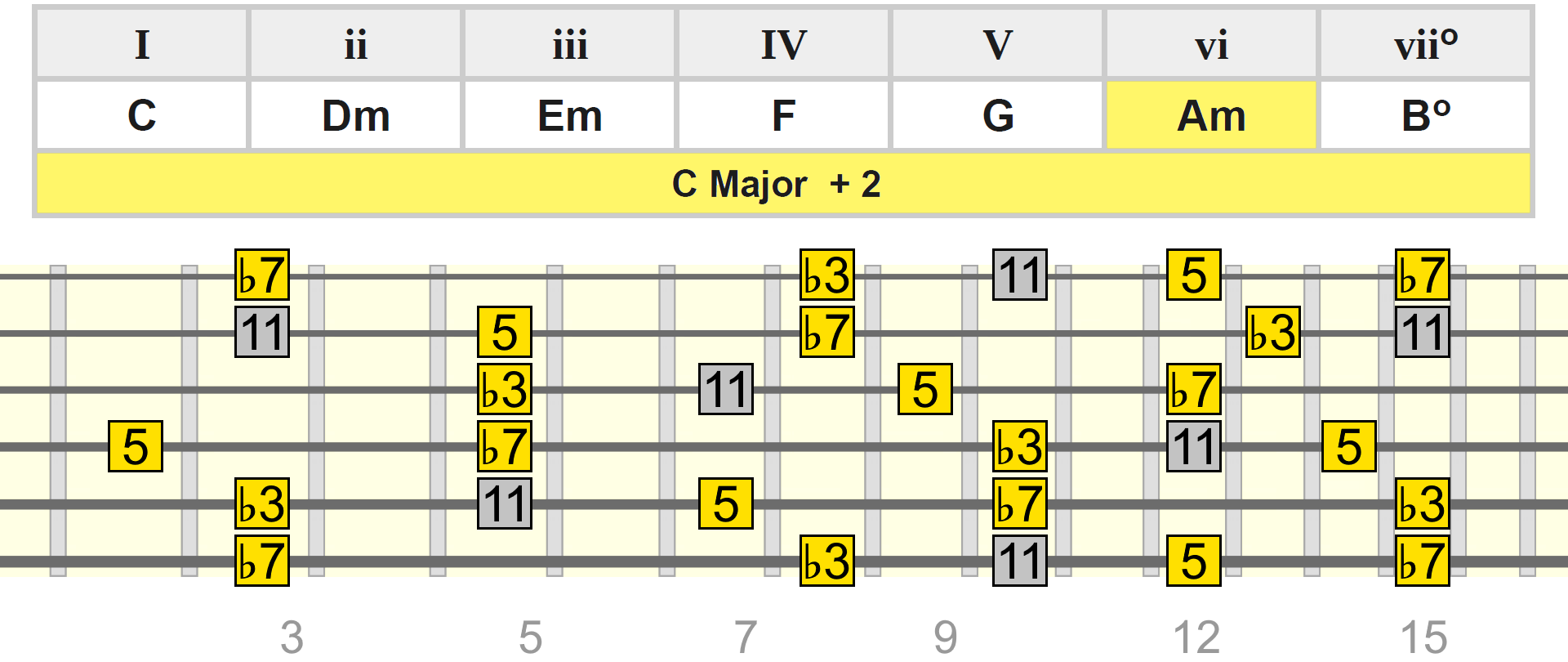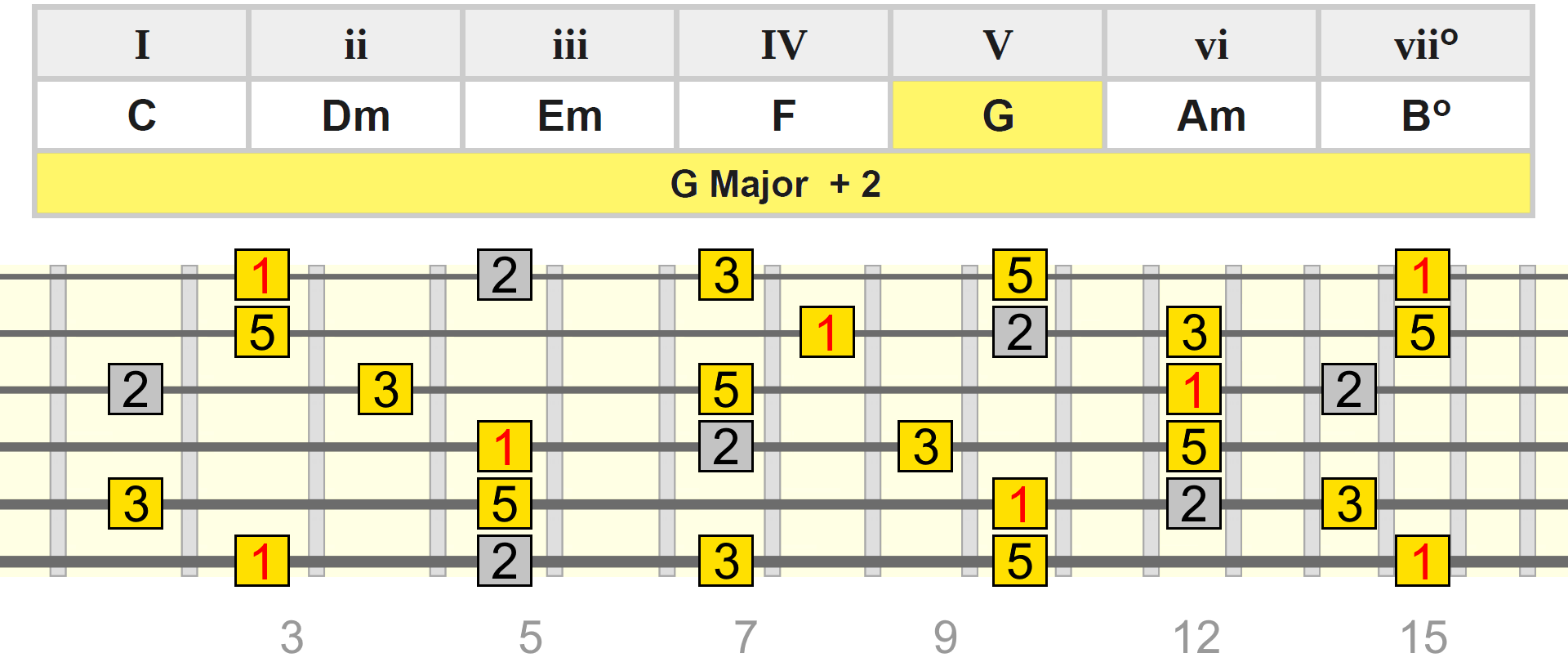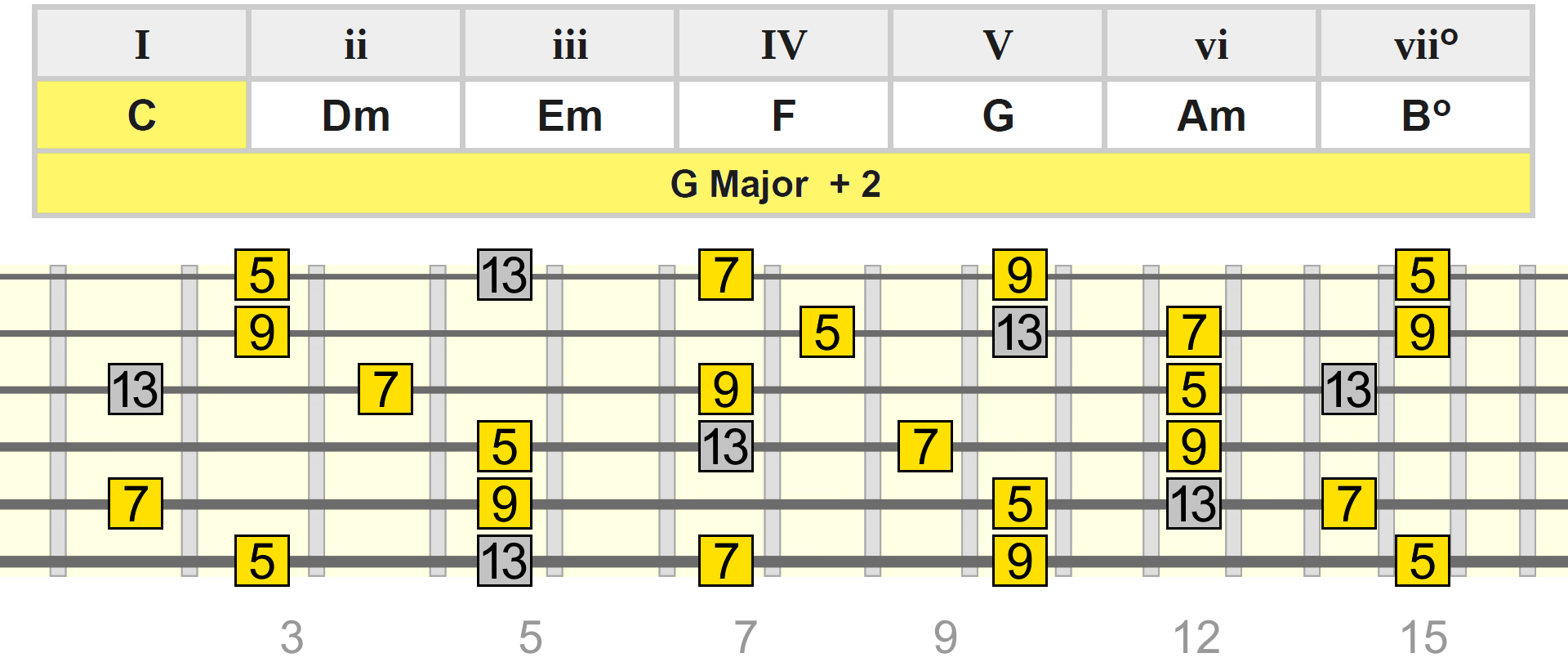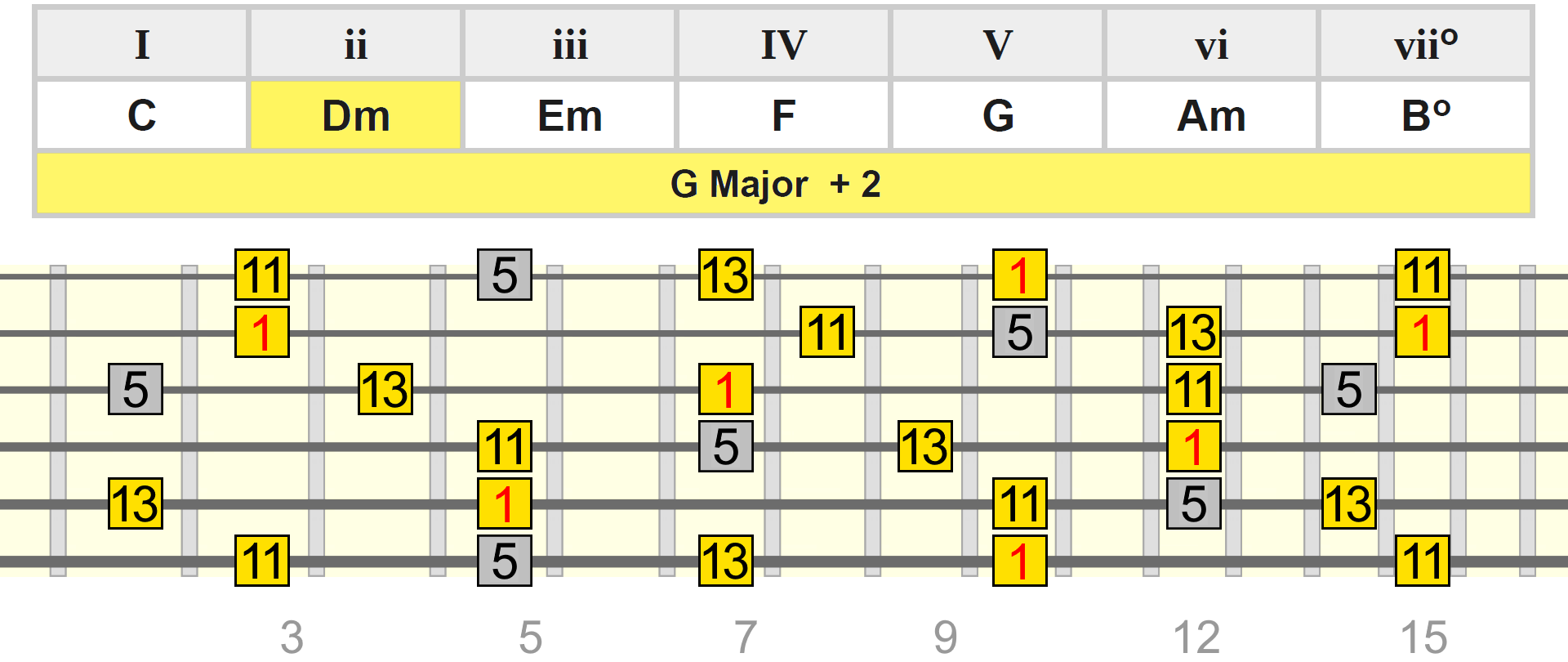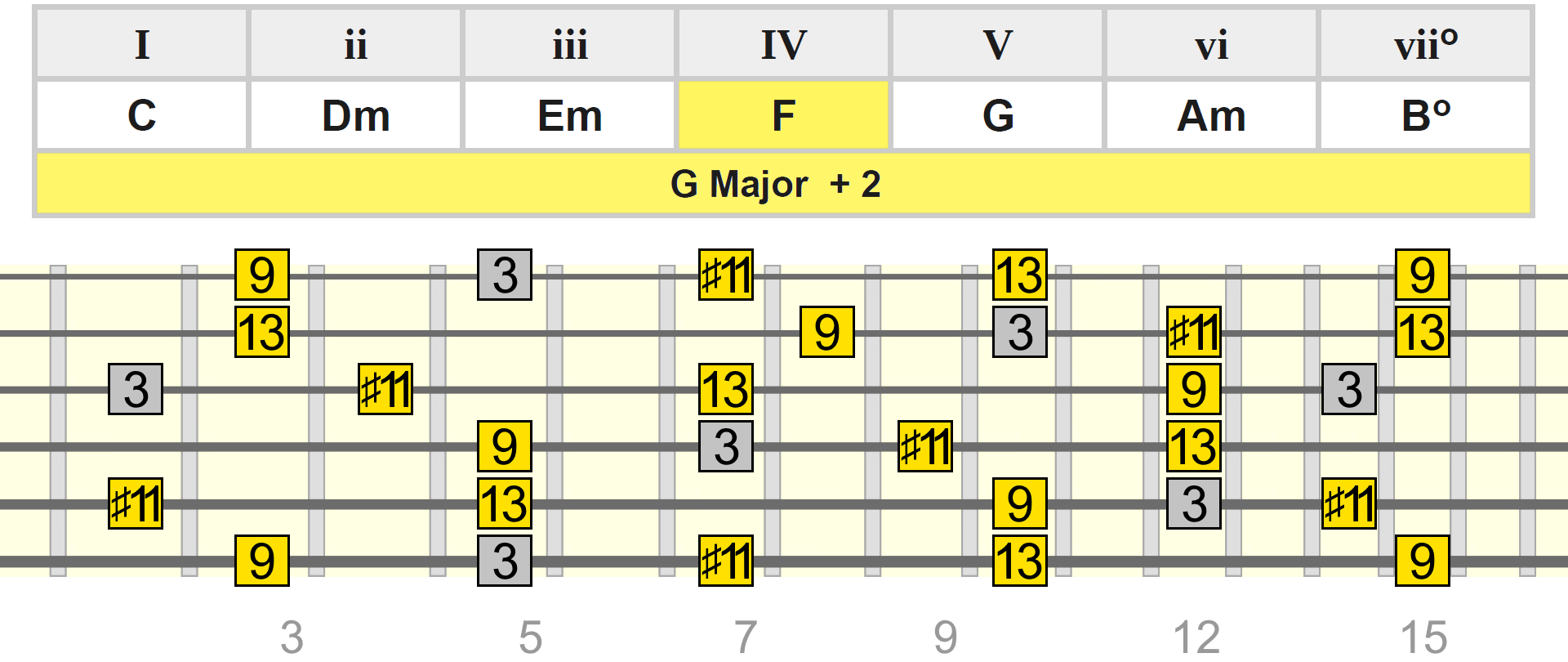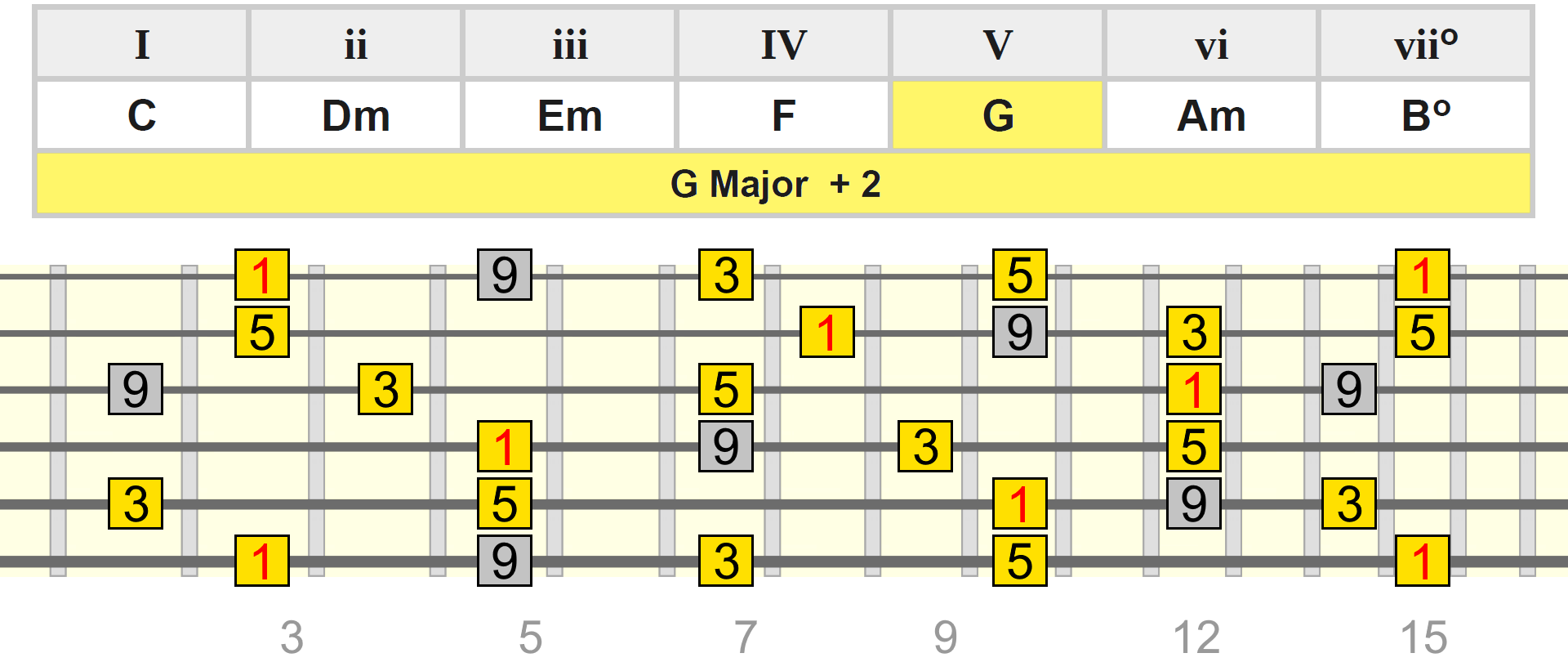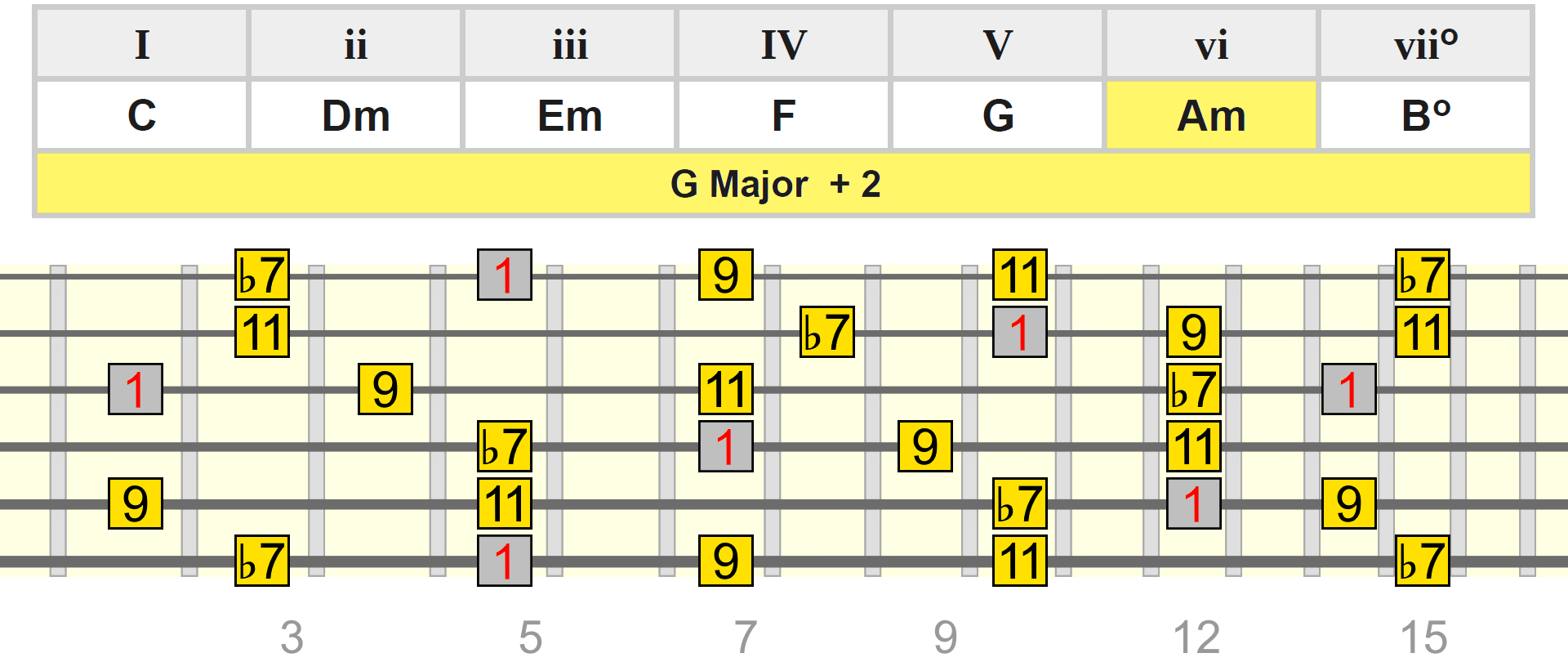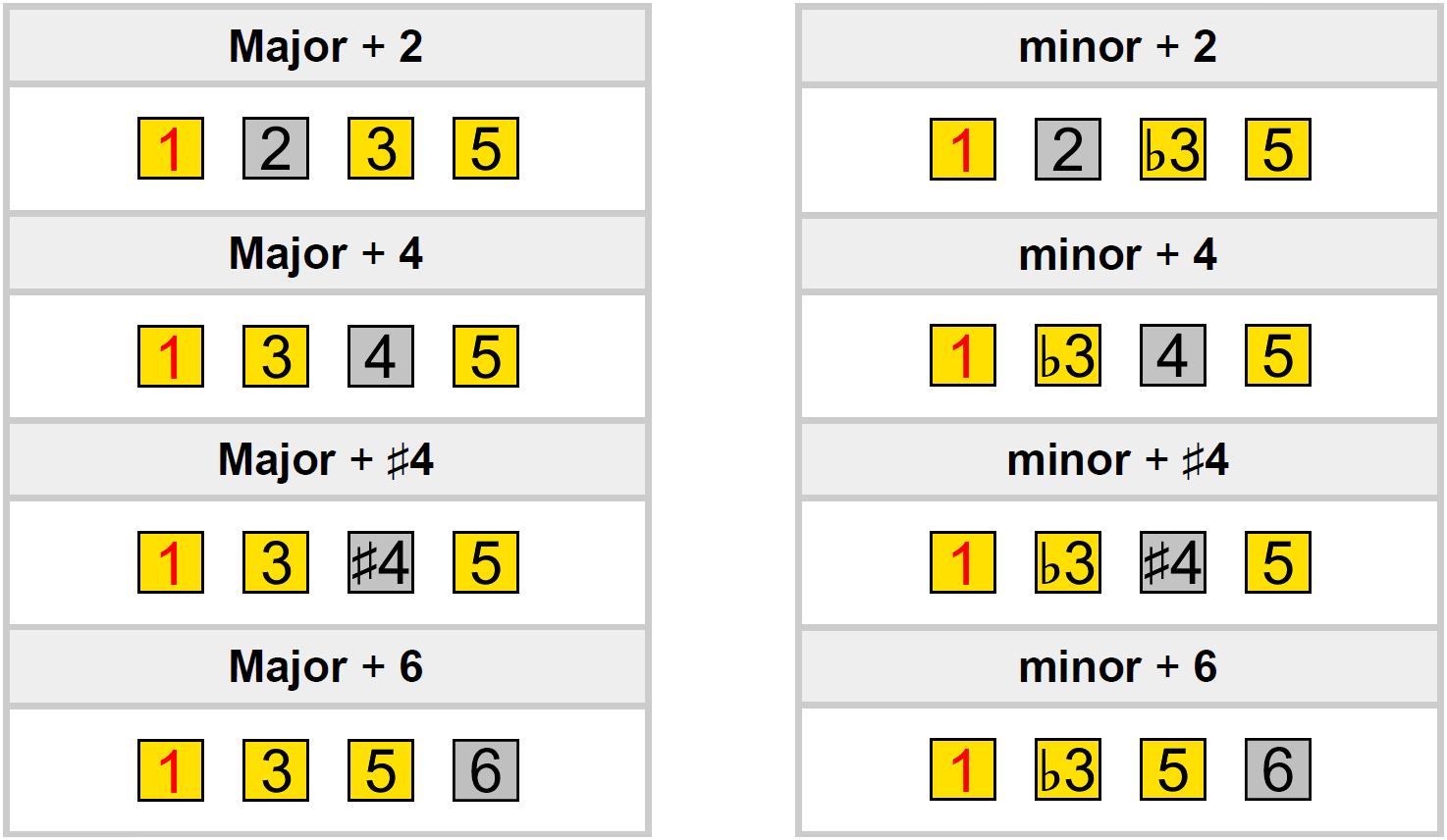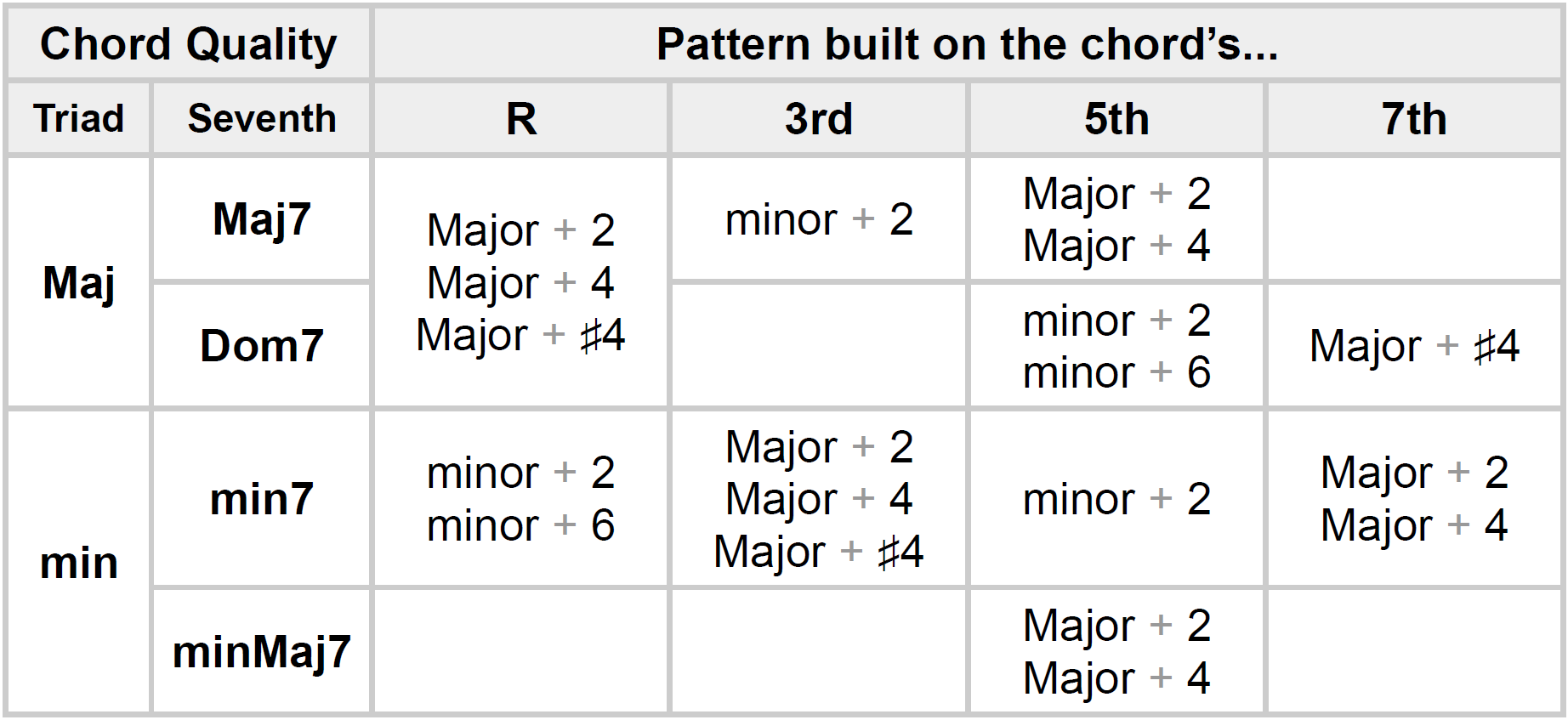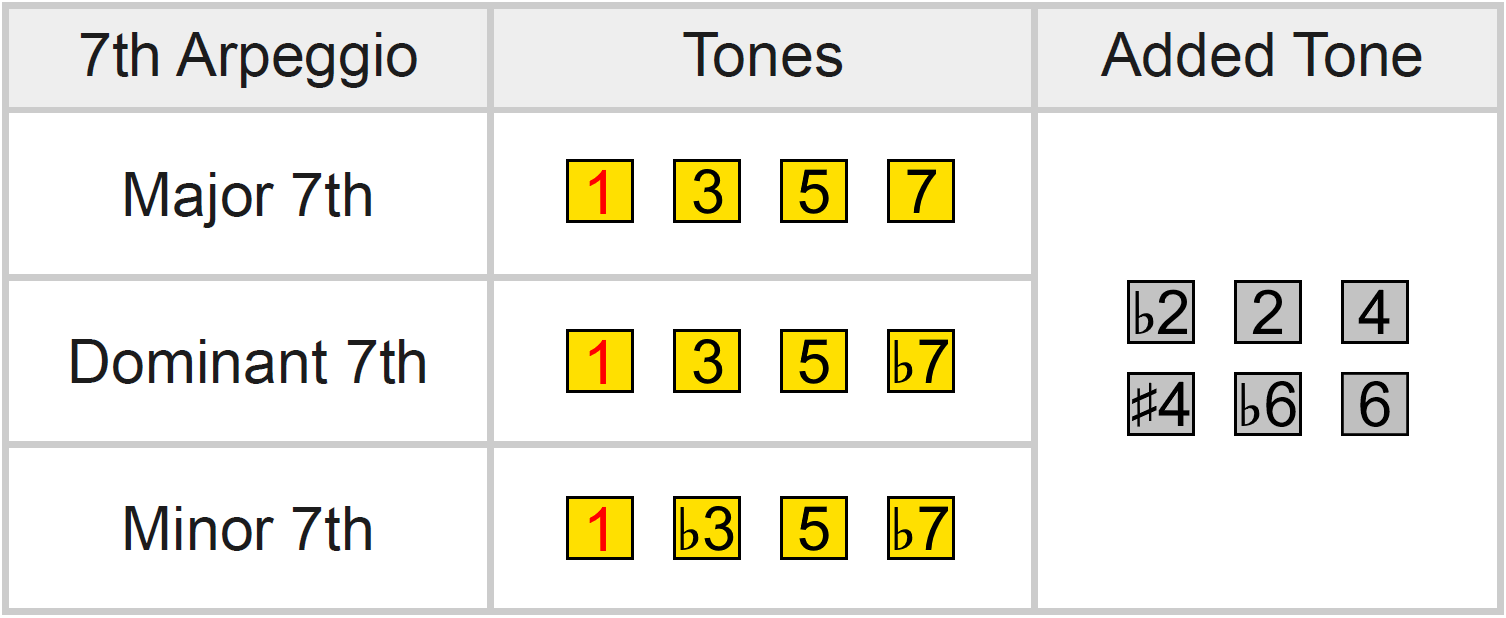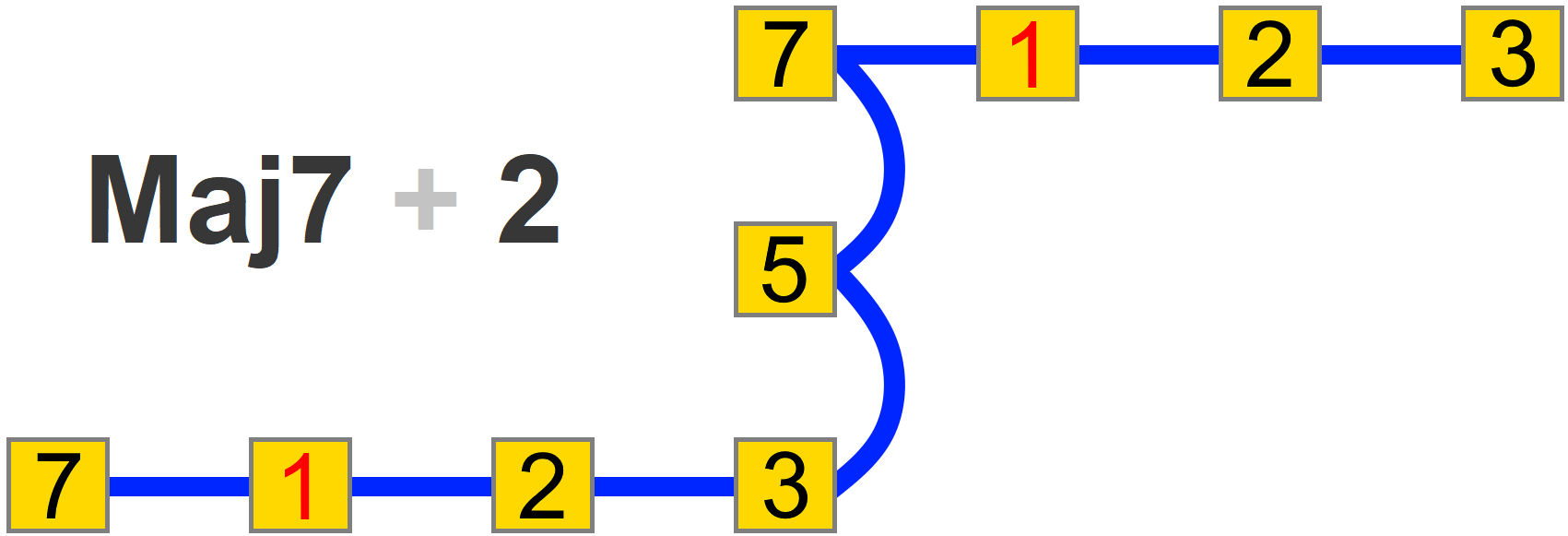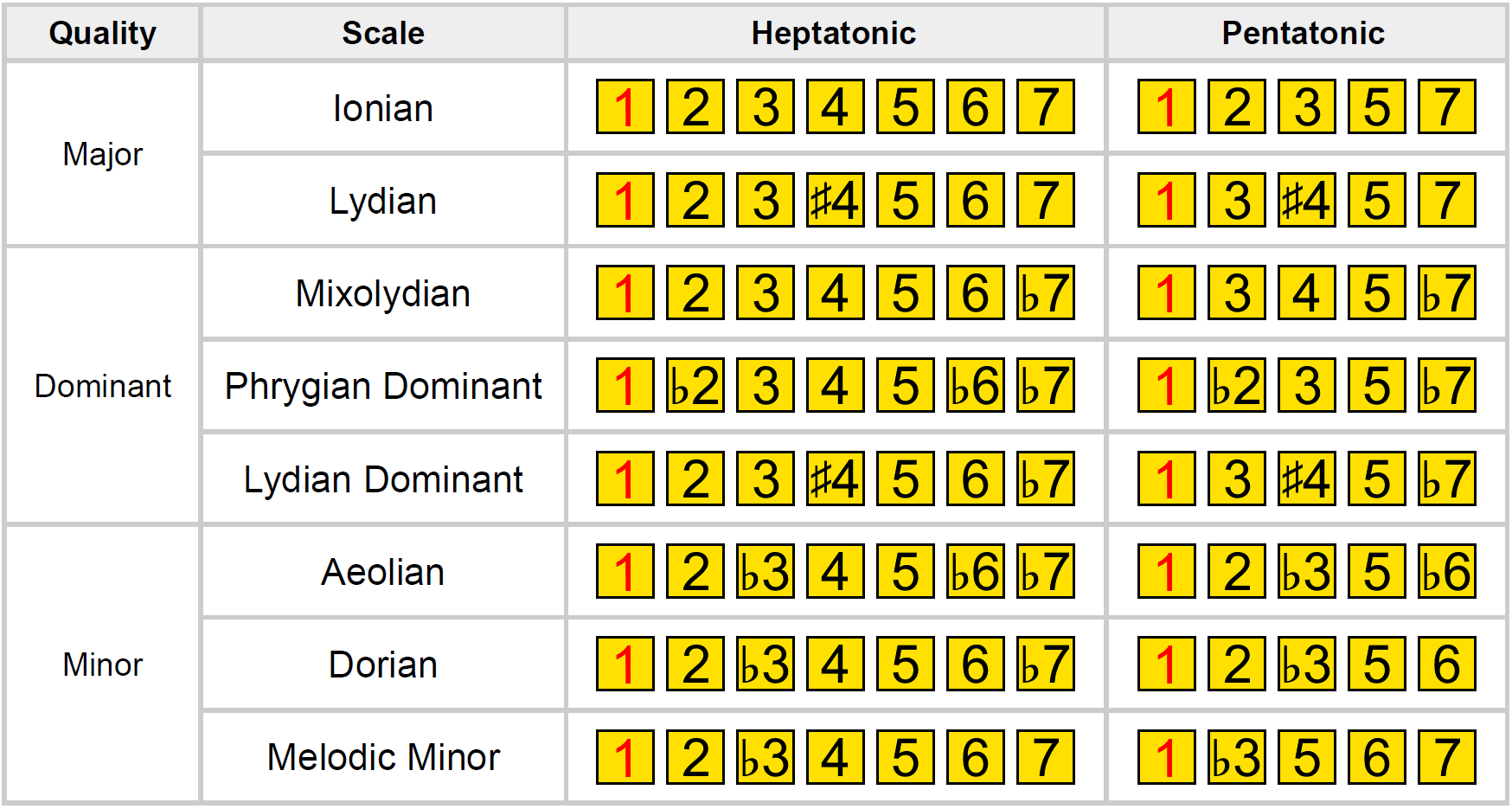The Basic Concept
As a starting point, each of the below patterns can be considered a major or minor arpeggio with one added tone.
So they have the form of regular arpeggios, but with the addition of a small fragment from a related scale. Kind of like a "ready made" vertical and horizontal phrase...
Major Patterns
Minor Patterns
Side note: You'll notice we're not yet using seventh arpeggios (i.e. maj7, dom7, min7, min/maj7) as, for now at least, we're focusing on other added tones and how they interact with the triad arp. By omitting the seventh, we're essentially making these patterns more versatile in terms of the different major and minor chords we can play them over.
Tonic & 5th Degree Patterns
First, we're going to take just two of the major patterns from above. For these examples we'll be in the relative keys of C major and A minor, both of which give us the same seven diatonic (or common) chords...
Maj + 4 Pattern on Major Tonic
Starting on the major tonic of C, we could build a major arpeggio as follows...
Now we're going to add the 4th from the C major scale, which can be seen as one half step up from the major 3rd, or a whole step down from the 5th...
The 4th gives the major arpeggio a nice additional leading momentum, like a passing melodic bridge within the arpeggio sequence, whether ascending or descending. Collectively it's basically the barebones of the Ionian sound.
Here, we're visualising a repeating pattern over three octaves. Start by getting to know it over that tonic major chord...
C Backing Track
Keep in mind with all these patterns, we don't have to play through the entire six string sequence. We can also see them as divided up into octaves and string pairings, starting and ending on any of the major arpeggio tones, not just the root.
Now, if we change the reference chord to Dm, or the ii chord of the C major key, that same "C added 4th" pattern takes on a Dm11 quality. This is because the intervals have changed their relationship to the reference chord underneath...
You can hear how the same embellished tonic C major arpeggio now sounds like an extension of Dm. Use the backing track below, which moves between C and Dm, to explore this pattern...
C - Dm Backing Track
Tip: When playing over the track, try to combine this added tone arpeggio pattern with a regular scale pattern (e.g. C major or C major pentatonic). Practice flowing into and out of the embellished arpeggio pattern as part of a larger phrase.
The pattern (still on the tonic position) gives us a similar effect on other chord degrees of the diatonic scale. For example the IV chord, over which the original pattern gives us a major 9th quality...
C - F Backing Track
With the V chord, we can see that we're touching on a 4th in relation to the degree's root, which would work especially well over a suspended 4th chord. The V chord is often suspended for added tension - something worth exploring and becoming familiar with...
C - G Backing Track
We can also hear how this same pattern would colour the relative minor tonic (or vi relative to major)...
Am Backing Track
So, one pattern, seven potential applications, without us having to move it from that tonic C position. Conveniently re-usable, colourful and melodic.
Of course, the idea is not to use it repeatedly over every single chord change in a diatonic key. But it's there as a reliable sequence, or as part of a larger phrase, that we can inject and flow into and out of over any chord in the major or relative minor key.
What makes this pattern especially versatile is that it will also work over some non-diatonic chords (i.e. chords that aren't harmonised from the major scale of the key) on the same tonic position.
For example, a ♭VII degree chord, also known as the subtonic (B♭ major in the key of C major). It'll work over both maj7 and dom7 on this degree, giving us a #11 Lydian flavour...

C - B♭ Backing Track
How about a minor iv chord (a common substitute for the major IV, so Fm in this case)? Over that chord the tonic major added 4th pattern gives us a fitting minor/major 7th quality...
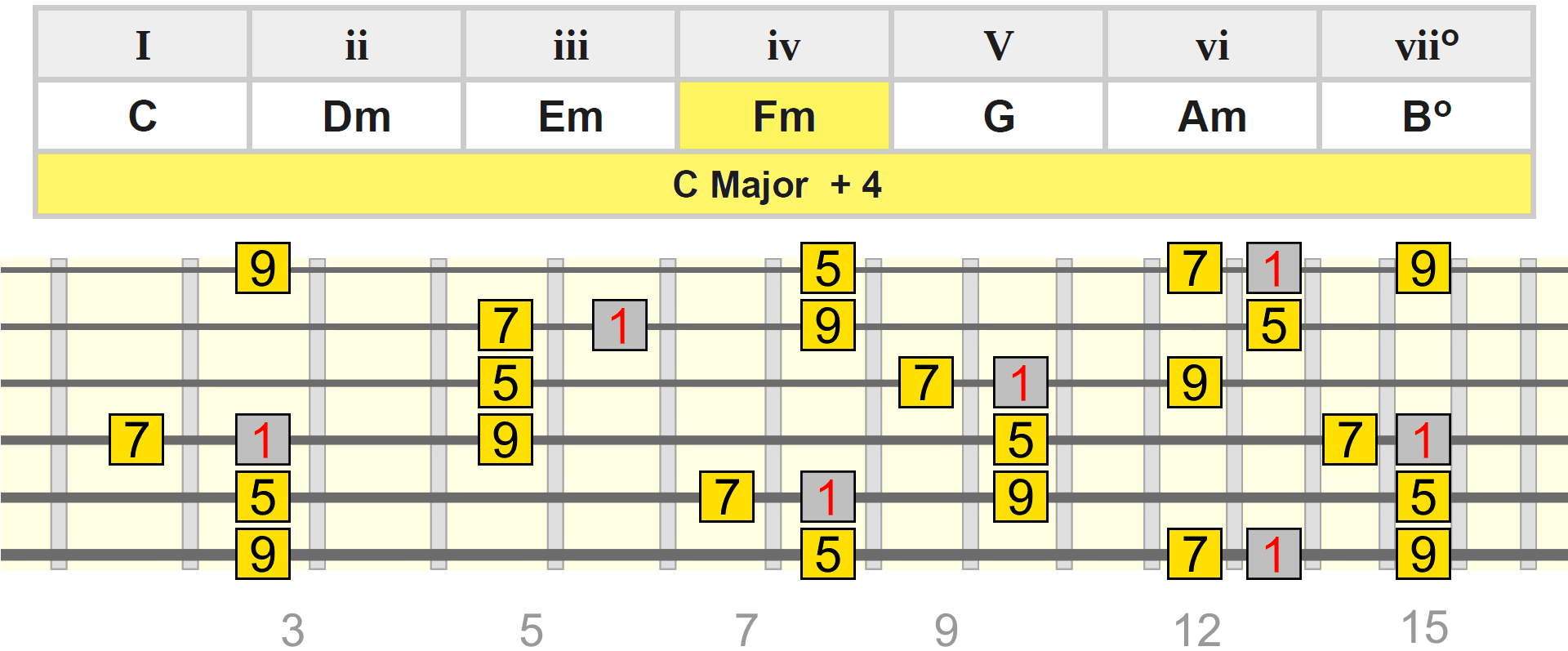
C - Fm Backing Track
Or a minor v chord (Gm in this case), giving us a minor 13th quality...
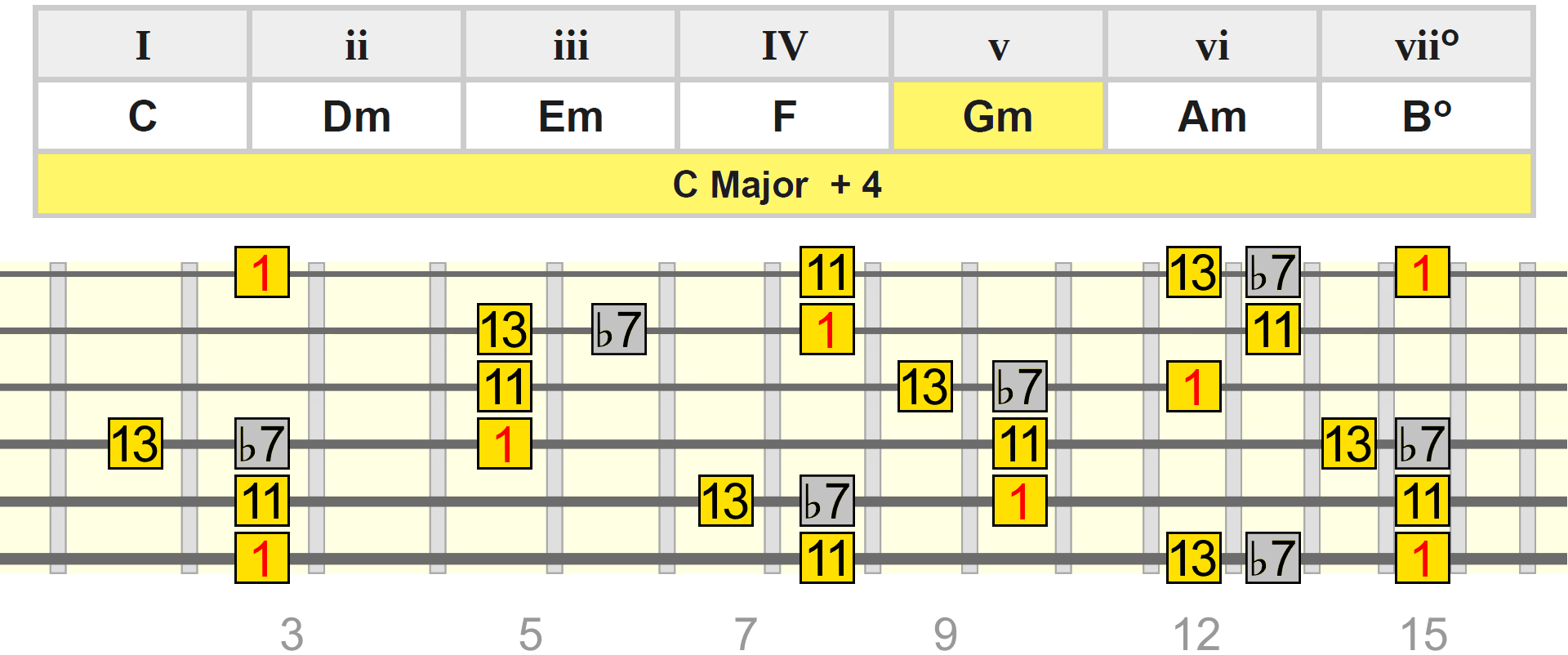
C - Gm Backing Track
So we can think of this kind of embellished arpeggio as re-usable, in different chord contexts.
Maj + 4 Pattern on 5th Degree
Now we're going to move that same "major added 4th" pattern to the 5th degree (or V) of the major key (G in this case)...
Not only will this work well over the V chord itself, but just like when we played it on the tonic position, it'll also colour the other six chords of the relative major and minor keys, as a fragment from the complete diatonic scale. Some examples...
Try playing the above pattern over the backing track below, which moves through a C major key. You can combine it with the C major or C major pentatonic scale, and also the C added 4th pattern from earlier to flesh things out...
C - Dm - F - G - Am Backing Track
Tip: What we're moving towards here is the ability to combine patterns seamlessly. So far, we have the "maj + 4" built on the tonic and V. So these two positions can be combined/connected within our major and minor key phrases, as fragments of the fuller scale. They can also be combined with pentatonic scales.
Maj + 2 Pattern on Major Tonic
Let's look at another pattern built on the major tonic. This time we're adding the 2nd from the scale to the major arp, one whole step from the 1. Over the tonic, it gives us a major added 9th (add9) quality...
Again, adding this tone to the tonic arpeggio creates a kind of arpeggio-scale hybrid sequence that gives us a phrasing pathway through all the diatonic chords of the relative keys.
It's just a fragment of the fuller diatonic scale, that moves us in certain directions, as one way of shaping meaningful phrases.
C - Dm - F - G - Am Backing Track
Tip: You'll notice from the tab/audio examples that we don't have to play the pattern in a straight sequence. We can skip tones and create larger ascending and descending jumps throughout the pattern, just like we can with regular arpeggios or scales.
This is mainly about shaping your phrases in non-linear ways to give your lead some variation.
Maj + 2 Pattern on 5th Degree
Let's now build the same major added 2 pattern on the V position (so Gadd2 in this case)...
Once again, as a fragment of the fuller scale, it's compatible with all the chords inside the relative diatonic keys, touching on related colour tones...
C - Dm - F - G - Am Backing Track
Together, these two patterns (maj + 2 and maj + 4), whether positioned on the tonic or 5th degree, represent different pathways through the diatonic major or minor scales, as a way of connecting vertical and horizontal movements over common chord changes. So they can be seen as a kind of diatonic arpeggio/scale hybrid.
Pattern Changes
As well as entire keys, we can connect these embellished arpeggio patterns to single chords and chord changes, matching the root position and triad quality of the pattern (i.e. major/minor) with the chord being played.
Here, we're going to bring in the additional patterns from earlier, again, each one representing a major or minor arpeggio with an added colour tone...
Two-Chord Changes
Let's say we were moving between C major and A♭ major. Over each of these chords we'd in theory have the choice of playing any of the major based patterns...
For example, over C we might play the C major add 2 pattern, moving to A♭ major with a #4. We might then resolve back to C using a C major add 4 pattern...
C - A♭ Backing Track
Many find it useful to visualise arpeggio and scale based patterns around chord shape positions, for example using the CAGED method, here shown using A♭ from the above example...
Playing between two chords like this is a good initial way to practice moving positions with your patterns. We're just trying to keep our phrases simple and manageable at this stage.
Another example. Below we're moving between Am and D, which could be thought of as a ii / V movement...
We might, for example, start with an Am + 2 pattern, move to Dmaj + 4, before resolving back to Am + 6...
Am - D Backing Track
We're by no means limited to these patterns. We can effectively add any tone to the basic major or minor arpeggio to create new phrasing pathways through chord changes and related scales...

Of course, the ♭7 and 7 will make up the seventh arpeggios we might already be familiar with. More on seventh arpeggios later.
Related Positioning
These patterns also work in related positions to the chord we're accompanying. This is where we place the 1 of our pattern on a tone other than the root of the reference chord.
Relative Major
For example, over a minor chord, we could use a major based pattern in the relative major position. That's the equivalent of playing from the minor 3rd of the reference chord, for example F major over D minor.
When positioned in this way, the major + 2 pattern gives us a minor 11th quality (e.g. F + 2 over Dm = Dm11)...
The major + ♯4 in the relative major position gives us a minor 13th quality (e.g. F + ♯4 over Dm = Dm13)...
Try both of these F patterns over the Dm track below...
Dm Backing Track
Major on the 5th of Minor
We could use major patterns on the 5th of a minor chord. For example, A major over D minor (A being the 5th of D).
Both the major + 2 and major + 4 patterns built on the 5th of the reference minor chord give us a dark, min/maj7 quality, which pairs up especially well with the melodic minor scale...
Dm Backing Track
Major on the ♭7 of Minor
On the ♭7 of the minor chord, which can be seen as a whole step down from the reference chord's root (e.g. C over Dm), we can again use both the major + 2 and major + 4 patterns to outline a minor 11th phrase...
Dm Backing Track
Dominant Extension
Another example, this time embellishing a major or dominant 7th chord.
Here we're playing a minor + 6 pattern on the 5th of a dominant 7th chord (e.g. Am6 over D7)...
Or a major + ♯4 pattern on the ♭7 of the same chord (e.g. C♯4 over D7)...
D7 Backing Track
Both these patterns/positions give us an extended, dominant 9th colour.
I'll be covering more of this type of "related positioning" on my Patreon (plus a lot more!). But the general concept here is that we can essentially re-purpose familiar patterns outside of the chord's root position to, again, create new phrasing pathways through different chord qualities...
Seventh Arpeggio Embellishment
Up until now, we've been creating four-tone patterns - a major or minor triad plus an added colour tone.
We also have the option of starting with a four-tone seventh arpeggio and adding a 5th tone, creating a kind of alternate pentatonic scale that connects to specific chord types and larger scales...
The concept is the same as before - to create a phrasing hybrid between linear/horizontal (i.e. step-wise) and vertical movement...
For example, here we're adding the 2nd to the major 7th arpeggio, on the A major key tonic...
Adding the 4th to the dominant 7th arpeggio, here built on E...
Adding the 2nd to the minor 7th arpeggio, here built on F♯...
Another way we could approach this is to add two colour tones to the triad arpeggios.
For example, here we're adding the 2nd and 6th to a B minor arpeggio...
Scale Connection
This kind of added tone arpeggio pattern can be seen as a pentatonic fragment from a related scale, some common examples of which are shown here...
These fragments are another way of giving our scale phrases more shape, because of the larger, non-linear interval jumps involved.
Start by adding these hybrid patterns to your regular major or minor pentatonic phrases as a way of introducing additional colour tones over chord changes. We'll be sure to look more at scale integration and chord connection in other lessons.
As always, thank you for your time!













